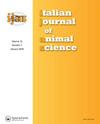神经瘤胃叶粕强化肉鸡饲粮对肉质脂肪酸代谢、定性、营养指标和感官评价的影响
IF 2.3
3区 农林科学
Q1 AGRICULTURE, DAIRY & ANIMAL SCIENCE
引用次数: 0
摘要
本试验研究了饲粮中添加神经瘤胃叶(RNL)对瘤胃脂肪酸(FAs)指标、感官评价、生产性能指标和饲料效率的影响。本研究包括五种治疗方法。处理1 - 4的肉鸡饲喂基础饲料加0、1、3和5 g/kg RNL,处理5的肉鸡饲喂基础饲料加抗生素Colimex。第34天,进行FAs谱和感官评价,并测定整个试验期的生产性能指标和饲料效率。结果表明,不同处理对鸡胸肉的FAs含量有不同程度的影响(p小于0.05)。饲粮添加1 g RNL时,二十碳五烯酸+二十二碳六烯酸含量最高,肉质品质最高,伸长指数最高,感官特性得到改善,并有提高生产性能指标、饲料效率和营养指标的趋势。5 g RNL处理降低了总饱和脂肪酸(ƩSFAs)、ω -6/ ω -3比值,特别是亚油酸/α-亚麻酸比值、丙氨酸转氨酶,增加了总ω -3脂肪酸、不饱和指数和Δ9-desaturase。综上所述,在肉鸡饲粮中添加RNL,特别是添加量为1 g时,RNL所含的植物成分可以改变肉中FAs的含量和指标,提高肉鸡的贮藏性和感官品质,从而促进肉鸡的健康和生产性能。本文章由计算机程序翻译,如有差异,请以英文原文为准。
Meat fatty acids profile including metabolic, qualitative, nutritional indices, and organoleptic evaluation as affected by Rumex nervosus leaves meal fortified broiler diets
The effects of dietary supplementation with Rumex nervosus leaves (RNL) on fatty acid (FAs) indices, organoleptic evaluation, performance index, and feed efficiency were investigated. This study consists of five treatments. Broilers in treatments 1–4 received basal feed plus RNL at doses of 0, 1, 3, and 5 g/kg, while broilers in treatment 5 received basal feed plus the antibiotic Colimex. On day 34, FAs profile and organoleptic assessment were evaluated, and performance index and feed efficiency were determined for the entire experimental period. Results showed that FAs profile of the breast meat was affected by treatments with varying degrees (p˂0.05). The 1 g RNL resulted in the highest eicosapentaenoic acid + docosahexaenoic acid, which resulted in the highest meat lipid quality, the highest elongation index, improved organoleptic characteristics, and tended to improve performance index, feed efficiency, and nutritional index. The 5 g RNL treatment reduced total saturated fatty acids (ƩSFAs), omega-6/omega-3 ratio, especially linoleic acid/α-linolenic acid ratio, alanine aminotransferase, and increased total omega-3 fatty acids, unsaturation index, and Δ9-desaturase. In conclusion, RNL can be introduced to broiler diets, especially at an incorporation rate of 1 g, and it promotes broiler health and performance because it contains phytoconstituents that can alter the content and indices of FAs meat and improve storability and sensory quality.
求助全文
通过发布文献求助,成功后即可免费获取论文全文。
去求助
来源期刊

Italian Journal of Animal Science
农林科学-奶制品与动物科学
CiteScore
4.90
自引率
8.00%
发文量
141
审稿时长
18-36 weeks
期刊介绍:
The Italian Journal of Animal Science is an international peer-reviewed open access journal publishing original scientific papers, reviews and short communications on animal science, animal production and related areas. The journal welcomes submissions on the following subjects:
• Animal derived food quality and safety
• Animal genetics and breeding
• Aquaculture, poultry, companion and wildlife
• Livestock systems, management and environment
• Non-ruminants nutrition and feeding
• Production physiology and biology
• Ruminants nutrition and feeding
Announcements of congresses, presentations of universities, research institutes, books and proceedings may also be published, as well as news regarding the members of the Animal Science and Production Association (ASPA). The Association will be glad to receive proposals for your admission as an ordinary or corresponding member: please read regulations and procedures in the statute of the ASPA .
 求助内容:
求助内容: 应助结果提醒方式:
应助结果提醒方式:


